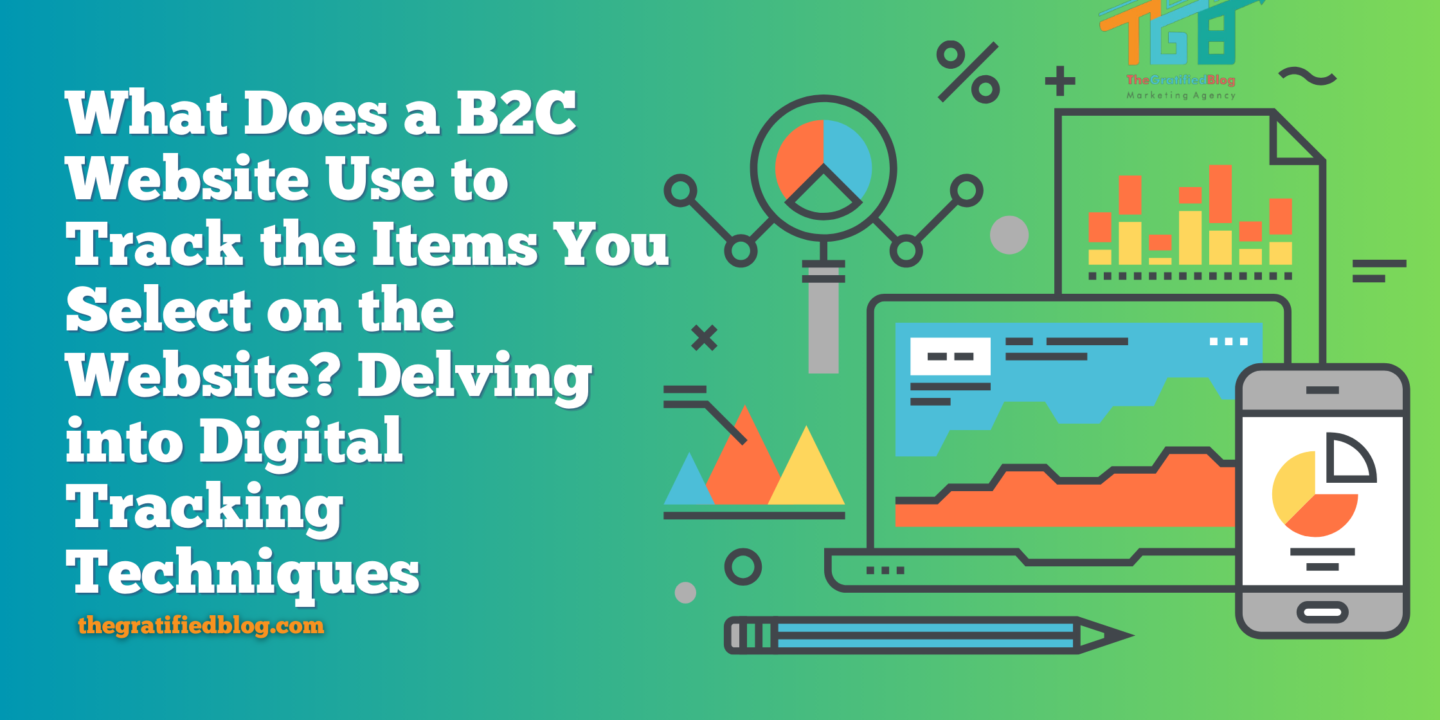
What does a B2C website use to track the items you select on the website? Have you ever asked this to yourself? Well, It can be scary how your favorite B2C websites seem to know your preferences like an old friend.
Picture this: you’re scrolling through an online store, contemplating that perfect purchase, and suddenly, like magic, recommendations tailored just for you pop up.
It’s not sorcery but the work of B2C website tracking. These platforms keep tabs on your every click and hover, crafting data to enhance your online shopping experience.
In this article, we will explore what B2C tracking is and which item selection methods to use.
Overview Of B2C Website Tracking
Have you ever felt the subtle guiding hand of online suggestions nudging you toward that perfect purchase? Well, that’s what B2C website tracking is about. It is where your every digital move is noted and molded into a personalized experience.
In B2C website tracking, clicks, hovers, and scrolls take center stage, crafting data that shapes your unique online journey.

Clicks, Hovers, And More
Your journey across a B2C website is more than a series of clicks—it’s a symphony of interactions meticulously orchestrated. Each click, hover, and scroll is a note in the tracking mechanism’s composition. Picture it as a digital dance floor where every move you make imprints your online footprint. This is how B2C platforms answer the query: what does a B2C website use to track the items you select on the website?
Behind the scenes, your digital profile is crafted from data points. It’s not just about the products you view or add to your cart but about your browsing patterns and decision-making process. This comprehensive understanding is critical when wondering what a B2C website uses to track the items you select on the website. B2C platforms leverage this to tailor recommendations uniquely suited to you. Your digital profile becomes a mirror reflecting your preferences, aspirations, and the nuances that make you you.
The Role Of Machine Learning In B2C Website Tracking
Algorithms analyze the patterns in your data, decoding the nuances of your preferences. It’s not just about what you’ve chosen; it’s about understanding the pattern of your choices. The algorithms decipher your clicks and hovers, translating them into personalized recommendations. This gives a clearer picture of what a B2C website uses to track the items you select on the website. You might not realize it, but these algorithms are the silent conductors orchestrating an experience tailored uniquely for you.
Machines become your digital confidantes, learning from your behavior with every interaction. Your choices, the time spent on specific pages, and the items that make it to your wishlist become valuable cues.

The Challenge Of Item Selection In B2C Website Tracking
You know the feeling—the overwhelming sea of choices on a B2C platform. As you navigate through myriad options, the platform faces the challenge of understanding your preferences amidst the vastness of its inventory. The focus is not merely on displaying products but on presenting the appropriate ones.
Finding the right balance between being helpful and overbearing can sometimes be difficult when offering suggestions. The platform is designed to assist you in locating what you need without overwhelming you. Striking this delicate balance is crucial for ensuring that recommendations enhance, rather than disrupt, your exploration on the site.
Picture this: you’re on a B2C platform, and the recommendations have failed. It happens. The frustration kicks in when what’s suggested aligns differently with your preferences.

What Does A B2C Website Use To Track The Items You Select On The Website?
When considering what a B2C website uses to monitor the items you choose on the website, understanding these methods is crucial. In B2C websites, the methods and strategies employed for item selection play a pivotal role in tailoring your online shopping experience. Here, we explore the sophisticated approaches platforms utilize to curate and present items that align seamlessly with your preferences and behaviors.
1. Recommendation Engines: Precision In Prediction
B2C websites are built with algorithms that predict your key inputs. Here’s how B2C websites recommend items to you.
- Data-Driven Insights
recommendation engines extract valuable data-driven insights into your preferences. By analyzing a wealth of information, these engines aim to understand your tastes and choices, contributing to a more tailored user experience.
- Algorithmic Analysis
Sophisticated algorithms come into play as they meticulously process the gathered data. These algorithms are designed to decipher patterns and trends, leveraging historical behavior to make predictions about your future preferences. The intricate analysis ensures a nuanced understanding of your evolving tastes.
- Personalized Suggestions
Building on the insights derived from algorithmic analysis, recommendation engines excel in providing highly personalized and relevant suggestions. Through constant refinement of their algorithms, these engines adapt to changes in your preferences, delivering recommendations that align closely with your unique tastes and interests.
2. Collaborative Filtering: Learning From Similar Users
B2C websites also learn the preferences of other users who share your tastes. The algorithm recommends items that other similar users have selected.
Here’s how B2C websites go about it:
- User Similarity
Collaborative filtering, a technique within recommendation systems, discerns users with akin preferences by analyzing their selections. This method leverages the collective wisdom of users with similar tastes, providing valuable insights into products or content that may resonate with a particular individual based on the preferences of their peers.
- Peer Recommendations
Items favored or chosen by users sharing similar tastes transform into recommendations for others. This peer-driven approach amplifies the relevance of suggestions, as it reflects the choices and preferences of individuals who have demonstrated compatibility in their selections.
- Social Dynamics
B2C platforms strategically harness social dynamics to enhance the item selection process. By tapping into the collective wisdom of a user community, these platforms enrich their recommendations with insights from a diverse set of users. This social influence contributes to a more dynamic and varied range of suggested items, catering to the diverse preferences within the user base.
3. Content-Based Filtering: Contextual Relevance
B2C websites are also thoughtful about recommending items based on their relevance. Items are filtered based on:
- Item Attributes
Content-based filtering is a method employed by recommendation systems to assess item attributes and descriptions, deciphering their contextual relevance. This approach focuses on understanding the intrinsic qualities of items, allowing platforms to make recommendations based on the specific characteristics and features of the content.
- Matching Preferences
The essence of content-based filtering lies in aligning the identified item attributes with your established preferences. By drawing connections between the inherent qualities of items and your known likes, platforms can recommend items that closely match your tastes. This personalized matching enhances the relevance of suggestions to cater to your individual preferences.
- Diversity in Recommendations
Strategic content-based filtering strategies go beyond merely matching preferences; they aim to introduce diversity in recommendations. By considering nuanced attributes, these systems expand the scope of potential selections, providing a variety of items that align with different facets of your preferences. This approach enriches the user experience by offering a well-rounded and varied set of recommendations.
4. Personalized Search Algorithms: Tailoring Discovery
The search algorithm baked into B2C websites can help you with item selection by:
- Understanding Intent
Personalized search algorithms transcend the limitations of keywords, delving into the intent behind your searches. By discerning the underlying motivations and context of your queries, these algorithms strive to deliver search results that align more closely with your specific needs and interests.
- Dynamic Ranking
Items are dynamically ranked to reflect your evolving preferences. This dynamic ranking mechanism ensures that the most relevant and preferred results are presented prominently, optimizing the user experience by placing items that resonate with your tastes at the forefront of search results.
- Real-Time Adjustments
The adaptability of personalized search extends to real-time adjustments that accommodate changes in your preferences. This continuous fine-tuning allows the search experience to evolve synchronously with your shifting interests, ensuring that the results remain aligned with your current preferences and providing a consistently tailored search journey.
5. Behavioral Analysis: Adapting To User Dynamics
B2C websites are also competent at identifying your behavioral patterns by incorporating real-time tracking. Here are more details:
- Real-Time Tracking
Behavioral analysis encompasses the dynamic process of real-time tracking, observing your interactions with items on the platform as they unfold. This ongoing monitoring allows platforms to capture the nuances of your behavior as you engage with content, providing a comprehensive understanding of your preferences in the moment.
- Identifying Patterns
An integral aspect of behavioral analysis involves identifying patterns in your interactions and selections. By discerning recurring behaviors and preferences, platforms adapt their item selections to align with the evolving patterns, ensuring that recommendations resonate with your consistently demonstrated tastes.
- Seasonal and Trend Analysis
Strategic recommendation systems incorporate seasonal and trend analysis into their approaches. By considering seasonal trends and staying attuned to emerging preferences, these systems enhance item curation. This proactive analysis ensures that recommendations not only align with your current preferences but also reflect broader trends and seasonal variations, providing a dynamic and up-to-date user experience.
6. A/B Testing: Iterative Refinement
A/B testing reflects a commitment to precision, relevance, and adaptability in presenting items that resonate with your unique preferences. B2C websites refine A/B testings by:
- Experimenting Frameworks
A/B testing is implemented through controlled experiments, allowing platforms to compare the effectiveness of different item selection strategies. This systematic approach enables a thorough evaluation of strategies to determine their impact on user experience and item recommendations.
- Iterate Improvements
In response to user feedback and responses from A/B testing, platforms embark on an iterative journey to refine and enhance their item recommendation approaches. This continuous improvement cycle is driven by a commitment to optimizing user satisfaction and ensuring that the recommendations align seamlessly with evolving user preferences.
- Adapt Algorithms
The dynamic nature of this methodology ensures that algorithms remain adaptable. By incorporating insights gained from experiments and user interactions, these algorithms evolve to accommodate changes in user behaviors and preferences over time. This adaptability is a key factor in sustaining the relevance and effectiveness of recommendation systems.
Future Trends In B2C Tracking
As technology continues to evolve, what a B2C website uses to track the items you select on the website will be influenced by innovative approaches that redefine the dynamics between businesses and consumers.
Here, we explore emerging trends to shape the next frontier of B2C tracking methodologies.
1. AI-Driven Hyper-Personalization
Undoubtedly, AI will flush through almost every sector, and B2C websites won’t be left out. Here’s what we expect from AI in B2C websites:
- Dynamic User Profiles
Artificial Intelligence (AI) will contribute to creating dynamic and real-time user profiles, capturing nuanced preferences and behaviors.
- Predictive Analytics
Advanced AI algorithms will move beyond reactive recommendations, employing predictive analytics to anticipate your preferences before expressing them.
- Contextual Awareness
AI will enhance contextual awareness, allowing B2C platforms to deliver hyper-personalized experiences based on location, time, and social context.
2. Extended Use Of Predictive Analytics
You’ll get anticipatory recommendations, and predictive analytics will be employed to offer ready recommendations, foreseeing your needs and desires. Here’s what we expect:
- Behavioral Forecasting
Platforms will utilize behavioral forecasting models to understand evolving trends, ensuring proactive adjustments in item selections.
- Informed Decision-Making
Predictive analytics will empower businesses to make informed decisions, from inventory management to marketing strategies, enhancing overall user satisfaction.
3. Augmented Reality (AR) Integration
Augmented Reality (AR) integration will also take hold of B2C websites. We expect AR to offer the following:
- Virtual Product Interaction
AR will enable virtual product interaction, allowing you to visualize and experience items in your physical space before purchasing.
- Enhanced Try-Before-You-Buy
B2C platforms will leverage AR for enhanced try-before-you-buy experiences, reducing uncertainties associated with online shopping.
- Immersive Shopping
The integration of AR will create immersive shopping experiences, bridging the gap between physical and online retail environments.
4. Blockchain For Enhanced Security And Transparency
Security and transparency will also be dialed up thanks to the incorporation of blockchain. Blockchain technology will be able to:
- Secure Data Transactions
The role of blockchain technology will be pivotal in securing B2C tracking data and ensuring the integrity and confidentiality of user information.
- Transparent Tracking
The decentralized nature of blockchain will enhance transparency in tracking mechanisms, allowing users greater control over their data.
- Immutable Records
Blockchain will facilitate the creation of immutable records, fostering trust between users and B2C tracking platforms.
5. Voice Commerce And Conversational Commerce
Voice commerce and conversational commerce will be a thing of the future. This can help you make purchases and seek recommendations in a breeze. Here’s what we are expecting:
- Natural Language Interaction
Voice-enabled interfaces will enable natural language interaction for seamless item selection and purchase.
- Conversational Recommendations
B2C platforms will utilize conversational commerce to provide personalized recommendations through virtual assistants.
- Multi-Channel Integration
Voice commerce will extend beyond standalone devices, integrating various channels to offer a cohesive and efficient shopping experience.
6. Ethical AI And Responsible Tracking
B2C platforms will prioritize ethical AI frameworks, ensuring user-centric and responsible tracking practices. Here’s what you’ll find in future B2C websites:
- Data Governance
Stricter data governance policies will be implemented to safeguard user privacy and instill confidence in B2C tracking processes.
- Transparency Initiatives
Transparent communication about tracking methods and adherence to ethical standards will become essential to future B2C tracking practices.
Conclusion
Every click, hover, and scroll strikes a personalized online experience. What does a B2C website use to track the items you select on the website? The answer lies in knowing the methods behind item selection, which include recommendation engines, collaborative filtering, content-based filtering, personalized search algorithms, behavioral analysis, and A/B testing.
But as we peer into the future, B2C websites will be incorporated with AI-driven hyper-personalization, extended use of predictive analytics, augmented reality integration, blockchain for enhanced security, and the advent of voice and conversational commerce.
Future trends in B2C tracking are not just innovation but a commitment to ethical AI and responsible monitoring. This ensures a harmonious blend of personalization and user-centric transparency in B2C tracking methodologies.








No Comments